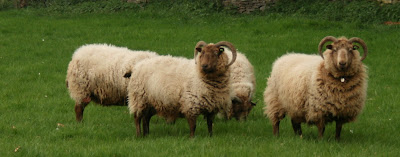 I have bought a second-hand WBC hive from eBay. Nice chap in Wellington, Somerset. It's a bit (wax)moth-eaten, but perfectly serviceable. And being made of cedar, it's light.
I have bought a second-hand WBC hive from eBay. Nice chap in Wellington, Somerset. It's a bit (wax)moth-eaten, but perfectly serviceable. And being made of cedar, it's light.I have set it up in a small paddock next to my friends D&D house - and it look splendid against the blackthorn blossom.
It's facing east - so it'll get the morning sun. and get the bees out and about. So - lesson learned (at last) from the hive in my garden, which is under a north-facing wall, and doesn't get a lot of sun.
 I have added a vial of swarm-lure. This is an artificial pheromone that will lure any swarm that is within sniffing distance (say, about half a mile). The makers claim that 50-80% of hives set up in this way will attract a swarm (provided the swarms are there at all).
I have added a vial of swarm-lure. This is an artificial pheromone that will lure any swarm that is within sniffing distance (say, about half a mile). The makers claim that 50-80% of hives set up in this way will attract a swarm (provided the swarms are there at all).It's a cheaper way of getting bees than paying £150 for a nucleus colony. Although, of course, you get what you get. And that might be a diseased colony with all sorts of maladies. It's a risk I'm prepared to take - because there are no other colonies on this site that would be infected.
The site is protected by these ferocious guard-sheep.
 On second thoughts, any herd of animals that are known by their first names cannot be that fierce.
On second thoughts, any herd of animals that are known by their first names cannot be that fierce.(Photos by Tom Summers, Guardian Competition-Winning Photographer.)






Fascinating subject Stephen.
ReplyDeleteOne of my neighbours was painting two new hives yesterday when I drove past.
Suddenly, I have noticed lots of hives appear in the fields where the rape is blooming (what a picture).
Yesterday, while driving through the lanes to Monflanquin with my children we passed through a black cloud of honey bees on the road.
I reversed back slowly into this cloud and we sat for about five minutes whilst (several million I guess) bees swarmed about.
The hives were about fifty metres away.
When I drove back about fifteen minutes later the swarm had dissipated and only a few remained - although I could see activity at the hives.
Adding your blog to my favourites Stephen :-0))
Welcome Philip and thanks for your comments.
ReplyDeleteOil Seed Rape yields about 120lbs of honey to the hectare. So you can work out the revenue at £4 a lb.
Steve